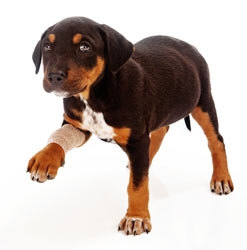Causes of Lameness in Dogs: An Overview

It can be very upsetting to see your dog limping or having trouble getting around. After all, many of the things that dogs love to do require good mobility and soundness of limb. Chasing balls, going for walks, and just moving normally around the home are all affected when a dog is suffering from lameness. The causes of limping in dogs are quite numerous. Below is an overview of many of the causes of lameness in dogs.
Remember, never give your dog any over-the-counter or prescription human medications without checking with your veterinarian first. Dogs metabolize medications differently than humans do, so giving improper drugs can be very dangerous or fatal.
Sprain, Strain, or Bruise
- Muscle strain, strain, or bruising can cause lameness in any leg, and can be quite painful.
- These muscle injuries can be secondary to trauma, play, or excessive exercise.
- The only treatments that are usually required are rest, anti-inflammatory medications, and possibly pain medications.
Fracture
- Fractures, or broken bones, can occur and cause lameness in any bone.
- These injuries are usually trauma-related.
- It is possible for a bone to fracture if it is weakened by bone cancer.
- The treatment required for fractures can range from bandages or splints to surgery.
Infections
- Infections that cause lameness can affect any limb.
- These conditions often cause a shifting-leg lameness (the dog may limp on the front, right leg one day and the rear, left leg the next).
- Organisms like Lyme and Ehrlicia cause systemic issues that include inflammation in joints, resulting in lameness.
- These conditions result in other signs of illness along with the lameness (inappetance and lethargy are the most common of these).
- The treatment for these infections is specific to the organism and usually involves antibiotics.
Diseases of the Foot Pad and Skin
- Diseases that affect the pads or skin of the feet can cause limping, and may affect any limb.
- These conditions include auto-immune diseases like lupus and pemphigus, parasitic diseases like mites, and traumatic foot-chewing secondary to allergies.
- The lameness associated with these conditions is due to pain in the skin or pad when pressure is placed on them.
- The treatment required for diseases of the foot pads or skin is specific to the diagnosis.
Wounds
- Wounds may cause lameness in any limb.
- These conditions include lacerations, broken nails, stings, and thorns.
- The treatment for wounds affecting the feet is specific for the type of wound that is present.
Hip Dysplasia
- Hip dysplasia causes rear leg lameness.
- This condition is an inherited (genetic) one that results in malformation of the hip joint.
- Hip dysplasia may be diagnosed at any age and is more common in large breed dogs.
- The severity of the lameness associated with hip dysplasia varies drastically between affected dogs.
- The treatment for this condition may be surgical. Anti-inflammatory medications, pain medications, and other treatments for joint inflammation are often used.
Elbow Dysplasia
- Elbow dysplasia causes front leg lameness.
- This condition is an inherited (genetic) one that results in malformation of the elbow joint.
- Elbow dysplasia is most often diagnosed in young animals.
- The severity of the lameness associated with elbow dysplasia varies drastically between affected dogs.
- The treatment for this condition is surgical. Anti-inflammatory medications, pain medications, and other treatments for joint inflammation are often used.
Arthritis
- Arthritis may affect any or multiple legs.
- This condition is also known as degenerative joint disease.
- Arthritis is caused by the break-down of cartilage in the joint.
- Normal aging may cause arthritis, or it may occur secondarily to another condition in the joint.
- The treatment for arthritis is pain management. This may include various medications, ensuring soft bedding, keeping the dog mildly active, and controlling weight.
Luxating Patella
- Luxating patella causes rear leg lameness.
- This is a condition where the kneecap pops in and out of place.
- Luxating patella is usually genetic but it may be also be trauma-induced.
- Mostly small breed dogs are affected by this condition, but some giant breeds are prone to it as well.
- The treatment for luxating patella is surgical.
Osteochondritis Dessicans (OCD)
- OCD can affect any leg.
- This condition occurs when the normal process of cartilage converting to bone in the dog's body is interrupted. This results in areas of cartilage that should be bone.
- OCD is believed to be genetic but in some cases it may also have a nutritional component.
- The treatment for OCD is surgical.
Panosteitis
- Panosteitis can affect any limb.
- This condition affects young, large breed dogs and is also known as "growing pains." German Shepherds are diagnosed with panosteitis most often.
- The cause of panosteitis is not known but it causes severe pain in the long bones of the legs of affected puppies.
- The treatment for panosteitis is pain management, as the condition is outgrown.
Legg-Perthes Disease
- Legg-Perthes Diseases causes rear leg lameness.
- This condition is caused by a loss of blood supply to the head of the femur (the ball of the hip joint) during growth. This results in the death of that section of bone.
- Legg-Perthes disease affects young, small breed dogs (terriers most commonly) and is usually genetic. It is possible for a trauma to the hip to cause Legg-Perthes as well.
- The treatment for Legg-Perthes Disease is surgical removal of the head of the femur.
Anterior Cruciate Ligament Rupture (ACL Rupture)
- ACL rupture causes rear leg lameness.
- This condition occurs when one of the knee's stabilizing ligaments is torn.
- ACL rupture is usually trauma-related and it is most often seen in large, athletic dogs.
- This condition also occurs in older, overweight dogs. In these cases, it is a slow stretching and weakening of the ligament that eventually results in a tear.
- The treatment for ACL rupture is surgical.
Bone Cancer
- Bone cancer may affect any limb.
- Osteosarcoma is the most frequently-diagnosed bone tumor in dogs.
- This condition is usually diagnosed in middle-age or older dogs.
- When bone cancer is present, the affected bones fracture more easily.
- The treatment for bone cancer is to surgically remove the tumor. Chemotherapy is then required, along with pain control.
Intervertebral Degenerative Disk Disease (IVDD)
- IVDD may affect any limb.
- This condition causes lameness when the soft material between the bones of the spine ruptures out or degenerates, affecting the nerve supply to the legs.
- IVDD may occur suddenly, associated with trauma, or have a slower onset, associated with chronic degeneration of the disks in older dogs.
- This condition may cause pain, weakness, or paralysis in the affected legs.
- IVDD may require surgery, or may respond to rest and medications.
There are some other, more rare neurological and muscle diseases that can also cause lameness. A thorough veterinary exam and possibly diagnostics such as bloodwork and x-rays are necessary to determine why your dog is limping. If your dog limps for more than a day or two, appears to be very painful and vocalizing, or has other signs of illness such as inappetance or lethargy, schedule a visit to your veterinarian right away.
You May Also Like These Articles:
Anterior Cruciate Ligament (ACL) Injury in Dogs
Medial Fragmented Coronoid Process
Osteochondritis Dessicans of the Humeral Condyle (OCD)
Panosteitis in Dogs: Growing Pains
Disclaimer: This website is not intended to replace professional consultation, diagnosis, or treatment by a licensed veterinarian. If you require any veterinary related advice, contact your veterinarian promptly. Information at DogHealth.com is exclusively of a general reference nature. Do not disregard veterinary advice or delay treatment as a result of accessing information at this site. Just Answer is an external service not affiliated with DogHealth.com.
Notice: Ask-a-Vet is an affiliated service for those who wish to speak with a veterinary professional about their pet's specific condition. Initially, a bot will ask questions to determine the general nature of your concern. Then, you will be transferred to a human. There is a charge for the service if you choose to connect to a veterinarian. Ask-a-Vet is not manned by the staff or owners of DogHealth.com, and the advice given should not delay or replace a visit to your veterinarian.



